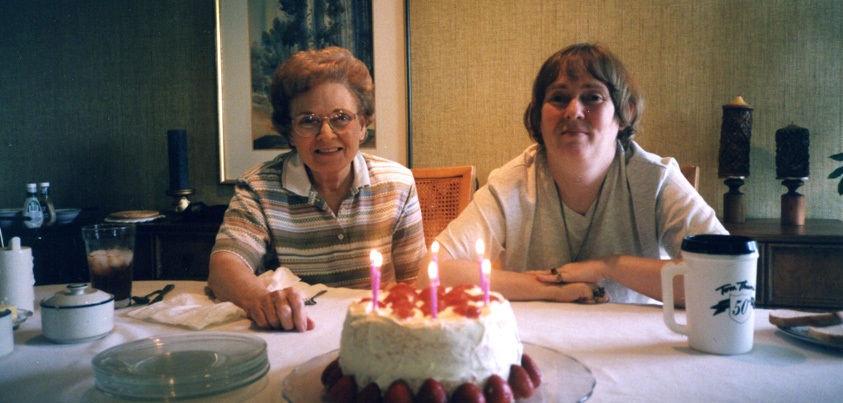NEWS

Making Pictures: Interview with Director Sophie Sartain
Sophie Sartain, director of "Mimi and Dona," spoke with Film Pittsburgh about her delightful experience documenting Mimi and Dona's search for an appropriate state-funded home for Sophie's 64-year-old aunt, Dona.
In 2009, Sophie Sartain began documenting the lives of Mimi and Dona, her grandmother and aunt, as they embarked on the difficult journey of finding 64-year-old Dona an appropriate state-funded home. As the project unfolded Sophie came across dozens of people grappling with the same predicament—a cousin, a neighbor or a friend's sibling, some with developmental disabilities, others with mental illnesses, all struggling to find appropriate care and housing for a loved one. Over the course of several years, Sophie traveled back and forth between Dallas and Los Angeles to document Mimi and Dona's story—one of tenderness, admiration, heartbreak, and personal growth. The result is a poignant, stunning documentary and a sincere portrayal of the impact of disability on families.
Sophie kindly took the time to answer some questions about her experience making Mimi and Dona.
Film Pittsburgh: How did your family respond when you approached them about making this film? Was there some apprehension or were they pretty open to it?
SS: My family was open to the filming, and I’m grateful to them for trusting me to tell this intimate and personal story. Mimi called my filming “making pictures.” “Oh, there you go again” she would say when I turned on the camera. “I don’t see why anyone would want to see pictures of me...” Then she would return to her regular life as if the camera wasn’t there. Although my mother is a private person, she was a good sport throughout filming. She once remarked that Ethel Kennedy let her filmmaker daughter Rory make a film about her, so she might as well be like Ethel!
FP: The film manages to be frank about your family and Dona’s struggles while also maintaining a level of lightheartedness that made it incredibly accessible. Did that balance come naturally?
SS: Thank you for saying that. Yes, the balance was natural. In addition to being fiercely devoted to one another, Mimi and Dona were quirky Texas characters. I knew there would be humorous moments between them, and I’m glad those exchanges came across on the screen. I wanted to show that despite the struggles, Mimi and Dona also enjoyed each other’s company and had a lot of fun.
FP: Can you speak to some of the challenges of representing people with developmental disabilities? Do you think your relationship with Dona made that easier or more difficult?
SS: Instead of the challenges, I’d like to focus on the DELIGHT I had in portraying my aunt Dona. She was the sweetest soul and could be very funny. Unlike many of us, she didn’t wear any social masks – you always knew exactly where she stood on things. Her honesty was refreshing and admirable. My son is on the autism spectrum, and he is similarly honest. While this can be a challenge on the playground, it endears him to adults. In presenting anyone on screen, I believe the main goal is to portray that person fully and honestly. To me this is the greatest form of respect, and I hope I was able to do that with my aunt Dona.

FP: You filmed this documentary over the course of several years. How did your intentions evolve over that time?
SS: I began filming my aunt and grandmother in 2009. In the beginning, I wasn’t sure if I was making a short film, a feature or just some home movies for the family. The project grew and evolved over time, especially after I filmed the scene of leaving my aunt at the state-supported living center. This footage was so dramatic and heartbreaking that I felt I might have a larger film. When I started filming, I was also concerned that my son, then age 4, might be on the autism spectrum. I wondered if I was beginning a journey that Mimi was about to end, with a child who might not follow the familiar path to independence. I wasn’t sure about including my personal situation in the story about Mimi and Dona, but ultimately, I decided to weave it in.
FP: As you’ve said, we are at the cusp of a crisis with our aging population of people with intellectual and developmental disabilities. How near or far do you think we are from a better solution? How can those with similar experiences and families help this cause?
SS: I am not an expert in this area, but the experts I have talked to feel strongly that this is a crisis. The numbers are alarming. A recent piece on NPR stated that there are 855,000 Americans with intellectual disabilities living with a caregiver over the age of 60. What happens when the aging caregiver dies, becomes ill, or for whatever reason can no longer care for that person? Because so many people like my aunt and grandmother live on the margins and out of the spotlight, their situation might not attract the same attention as other pressing social issues. My hope is that this film will raise awareness, encourage dialogue and embolden families to ask for more services and housing options for their loved ones. We may not have all the answers, but we can at least speak out and rattle the cages.